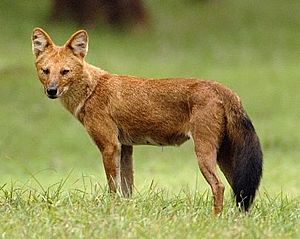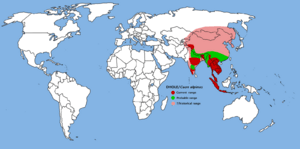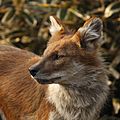Dhole facts for kids
Quick facts for kids DholeTemporal range: 0.781 mya
Pleistocene – Recent |
|
|---|---|
 |
|
| Conservation status | |
| Scientific classification | |
| Kingdom: | |
| Phylum: | |
| Class: | |
| Order: | |
| Family: | |
| Subfamily: | |
| Genus: |
Cuon
|
| Binomial name | |
| Cuon alpinus |
|
 |
|
| Dhole range | |
The dhole (Cuon alpinus) is a wild dog from Asia. It is related to other dog-like animals, like domestic dogs and foxes. You can find dholes in parts of Central, South, and Southeast Asia. People call them by many names, such as the Asiatic wild dog, Indian wild dog, whistling dog, red dog, or mountain wolf. Dholes are very close relatives of animals in the Canis group, which includes dogs and wolves.
Long ago, during the Pleistocene Ice Age, dholes lived across Asia, Europe, and North America. But about 12,000 to 18,000 years ago, they disappeared from most of these places. Now, they only live in certain parts of Asia.
Contents
Dhole Life and Habits
Dholes live in large, loosely connected groups. These groups often have several females that can have babies. A typical dhole group has about 12 members. However, some very large groups can have over 40 dholes!
Daily Life and Hunting
Dholes are active during the day. They hunt together in their groups. They usually eat medium to large hoofed animals. These are animals like deer or wild pigs.
In tropical forests, dholes share their home with big cats like tigers and leopards. They all hunt for food. While dholes might go after slightly different animals, their diets often overlap. This means they sometimes compete for the same food.
Why Dholes Are Endangered
The dhole is listed as an Endangered animal by the IUCN. This means there are very few dholes left in the wild. Their population is shrinking. Scientists believe there are probably fewer than 2,500 adult dholes remaining.
Threats to Dholes
Several things are causing the dhole population to get smaller:
- Loss of habitat: Their homes are disappearing. Forests and wild areas where they live are being cut down or changed by humans.
- Lack of food: There isn't enough food for them to eat. The animals they hunt are also becoming fewer.
- Competition: They compete with other animals for food and space.
- Hunting: Sometimes, dholes are hunted by people.
- Diseases: They can catch diseases from pet dogs. These diseases can be very dangerous for wild dholes.
Images for kids
See also
 In Spanish: Cuón para niños
In Spanish: Cuón para niños












